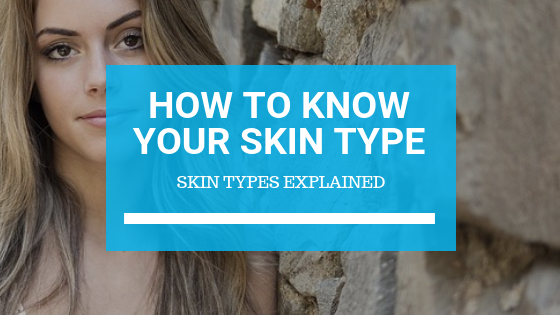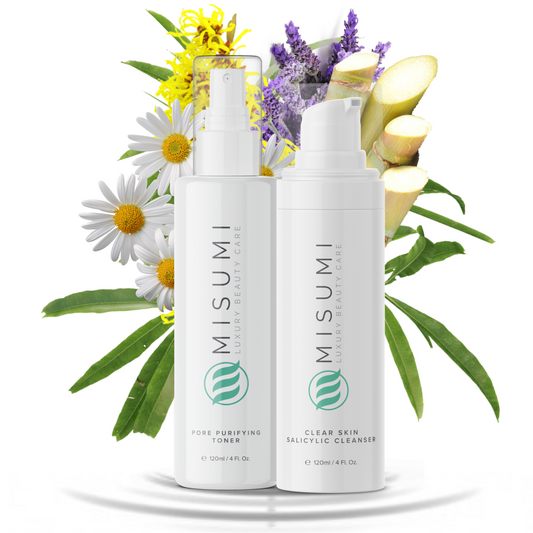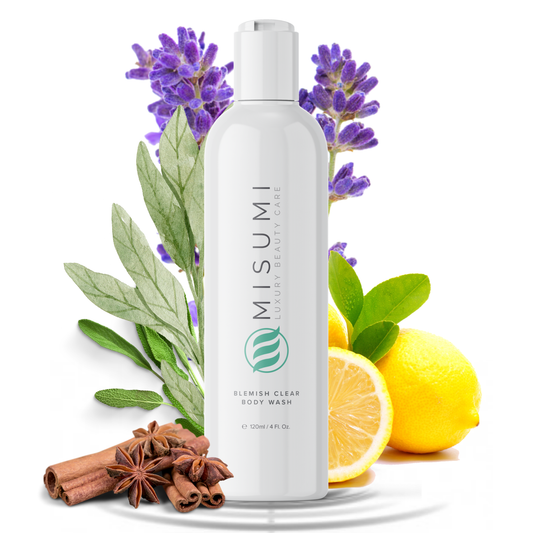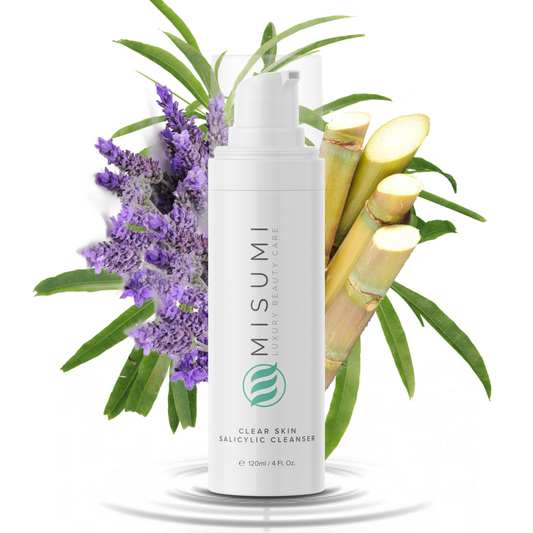Have you ever jumped from one product to another, wondering why they're not working out for you? Well, you might be having trouble determining your skin type.
Knowing your skin type is the single most important step in fighting any skin issues such as acne or hyperpigmentation, Not to mention - you need to know your skin type to have an effective skin care routine with suitable products. (Take Misumi's Complete Clear 3-Step System, for example.)
There are five main skin types, and getting yours wrong is one of the biggest mistakes you can make on your skincare journey.

The skin is our biggest organ, after all. So it makes sense that if you mistreat it by using unsuitable and harsh products, it won't respond well. Knowing your skin type might not be a quick and easy process, but it's definitely worth it, saving you a lot of time in the future.
So, where should you begin?
You can actually figure out your own skin type just by doing a couple of tests. Of course, you can always consult a professional, but with a little patience and perseverance, you can discover it all on your own.
How to Determine Your Skin Type
There are only a few basic skin types to choose from. The simplest way to determine your skin type is by removing any makeup that's sitting on top of your skin, washing your face thoroughly, and drying it using a soft, clean towel.
Don't continue with your skincare routine just yet. Before applying any toner, moisturizer, serum or spot treatment, take a good look at your skin. Feel it on your fingertips. Now that you've felt your skin let half an hour pass before you repeat the same physical examination. Again, don't apply any skincare treatments just yet - your skin needs to be bare to get a proper diagnosis.
Pay close attention to the cheeks, forehead, chin, and nose. Does it feel oily? Does it feel dehydrated? Is there a subtle shine, or do you have a skin texture like the Sahara desert?
Let another half an hour pass. Then, make a few facial expressions and see if you're having any trouble smiling or raising your brows. If your skin feels tight, like it might crack, chances are you have dry skin.
If your skin feels the same as usual, you're one of the lucky ones and most likely have normal skin. If there's a shine, then it's probably oily or combination skin.
If you have an oily T-zone (the area of your forehead, between your brows, nose, and chin), then it's probably combination skin. However, if your cheeks feel greasy, you definitely have oily skin.
If you notice red patches, you might be suffering sensitive skin.
Another good determiner of your skin type is your pore size. Take a close look in the mirror and pay attention to the size of your pores. If they're visible but not overly large, then you probably have normal skin. Step away from the mirror and take another look. If they are still visible, chances are you have oily skin. Dry skin tends to have invisible pores. A mash-up between small and enlarged pores is associated with combination skin types.

The Blotting Sheet Method
Now that you've finished playing detective, you might want to double-check you're correct. Luckily for you, another method can help you determine your skin type.
This method is quicker and will help determine whether your skin is oily or dry. For this method, you'll need a bloating sheet. These are typically found in conventional drugstores and supermarkets - and even some makeup counters carry them.
Take a bloating sheet (sometimes known as blotting paper) and gently pat it all over your face. Wait a few seconds for the oils on your face to be absorbed. Then, take the sheet and bring it to light.
If you see visible traces of oil on the blotting sheet, you have either oily or combination skin. If there's no oil in sight, then you have dry skin. If the oil comes from the T-zone, it's definitely a case of combination skin.
Since we've mentioned all the ways you can determine your specific skin type, let's delve into each one more and which treatment options are the best for different skin types.
Dry Skin Type
Having a dry skin type is no walk in the park.
You have minimal oil. You constantly have to apply moisturizer, makeup looks very cakey, and taking a shower can make your skin feel like it might crack. It feels tight and rough throughout the day, and there are visible dry patches on the surface of your skin.
So, which factors influence dry skin? Truth be told, our skin types depend mainly on our genetics. Those genetics can be exacerbated by certain environmental factors such as diet, not getting enough sleep, hydration levels, excessive sun exposure (leading to sun damage), chlorine, hormonal imbalances, hard water, climate changes, and extreme temperatures.

Here are a few tips to help you battle extremely dry skin:
Nourishment comes from within, so ensure you stay hydrated throughout the day. Include many fruits and vegetables in your diet, since they’re a primary source of antioxidants. Make sure you exercise a couple of times a week and get enough sleep as this will all help dehydrated skin.
In terms of skincare, moisturizing regularly is crucial! Pick a moisturizer that’s specifically designed for dry skin. On top of that, you should also exfoliate regularly and apply hydrating face masks. Although try not to do it more than three times a week.
Oily Skin Type
The most obvious trait of oily skin is the production of excess sebum. The skin produces more oil than any other type. The sebaceous glands can overproduce sebum for various different reasons, but for the majority of people, oily skin (or acne-prone skin) is the result of genetics.
If you have excess oil, you'll end up with clogged pores, and if there are acne-causing bacteria in your skin, chances are you will break out. You're probably always purchasing different spot treatments. (Things like benzoyl peroxide, salicylic acid, and glycolic acid can do wonders for acne-prone skin.)
Oily skin can frustrate people who wear makeup as the oil can soak through even after applying powder to your skin. To fix this problem, it's best to use a combination of blotting sheets and mattifying foundations specifically targeted at those with this type of skin.

It's not all doom and gloom, though! Believe it or not, there are actual upsides to having oily skin. It's less likely to show signs of premature signs of aging and it looks younger as a result. This is because the natural oils in your skin make it less prone to developing fine lines and wrinkles.
Sometimes it might seem like there's nothing you can do to remove the excess oil. However, there are certain steps you can take to minimize the amount of sebum your skin produces and reduce clogged pores.
Exfoliating regularly will do wonders for preventing regular cell detoxifying. However, even though your instincts might tell you to pick up the most abrasive skin exfoliator out there, choose gentler ones that will remove dead skin cells without harm. This will ensure you aren't causing any damage to the skin in the long run.
Don’t overdo the exfoliating though! As paradoxical as it might sound, that can actually cause your skin to produce even more sebum. If you're stripping your skin from its natural oils, the skin will signal to the glands to produce even more oil than before, causing oily mayhem.
While we're on the subject, some people might feel inclined to over-wash their face to combat the shine. This actually won't help get rid of excess sebum, so it's best to wash your face just two times a day – in the morning and before going to bed.
Your best bet is to use a gentle cleanser designed for oily or acne-prone skin. Take Misumi's Clear Skin Salicylic Cleanser, for example. Its deep pore-penetrating power will help control oily skin, remove impurities, and lock in moisture without making the skin greasy.

A drawback of having oily skin is that it's more likely to cause hyperpigmentation after breaking out. Getting rid of hyperpigmentation is not an easy task, so it's best to do all you can to prevent it from happening. Regular exfoliation, wearing a broad-spectrum sunscreen, and using proper skincare such as Retin A creams will help you minimize the chance of dark spots and marks.
If you have oily skin, you'll want to avoid any makeup and skin care products that contain oil. It can clog your pores and lead to acne. Avoid any kind of alcohol because it can dry out the skin.
Combination Skin

Combination skin is characterized by oiliness in the T-zone and dryness in the cheek area. This can be a problem for many people because they don't know which skincare products to pick.
Using products suitable for oily skin won't benefit dry areas and may make your skin feel tight, and using products for dry skin may make you feel even oilier. Thankfully, nowadays, many ranges are specifically designed for people who have combination skin. It's easy to pick up a mild cleanser or face wash for this skin condition.
Opt for moisturizers that aren't too heavy on the skin so you don't throw off the oily parts. The moisturizer you pick should hydrate the skin properly without aggravating the T-zone.
As with oily skin, those who have combination skin should avoid putting any alcohol on the face since it will likely cause dry patches. You might find reading ingredients on your skincare products boring, but trust us - you're saving yourself from a lot of trouble in the future.
Normal Skin Type
If you have normal skin, consider yourself lucky! People with normal skin might experience some oiliness and dryness here and there, but, for the most part, it's a steady ride.
If you do break out from time to time, it's usually temporary, and the breakouts go away on their own without leaving a mark. You don't need to worry about using new products on normal skin since the chances of you having a negative reaction are minimal.

Normal skin is pretty easy to manage, but make sure you aren't neglecting it too much. Create a proper skincare routine consisting of a gentle cleanser and moisturizer to hydrate the skin and protect it from the sun. If you're in your twenties, you might want to look into getting some anti-aging products as well, just as a preventative measure for normal skin.
Sensitive Skin Type
Here are some of the most common symptoms in people who have sensitive skin: frequent breakouts, easily inflamed and irritated skin, itchy skin, chronic redness, flushing, and negative reactions to new products.

Dealing with sensitive skin is not an easy task, and you'll face problems other skin types won't have to consider in their wildest dreams. It will definitely take some time and patience to find the products which work best for you. You have to keep an eye on your skin's reaction to certain ingredients and do your best to avoid those which cause you harm.
Lucky for us, there are more than enough products targeted specifically to those who have sensitive skin. Most of these won't contain dangerous and triggering ingredients.
Generally speaking, fragrances, colorants, alcohols, silicones, and oils cause problems in most people with sensitive skin. Look for labels such as "suitable for sensitive skin", "non-comedogenic", "paraben free", "alcohol-free", and "oil-free". If you want to try out a completely new routine, make sure you introduce one product at a time, so you can identify any potential triggers.
Sensitive skin types usually have a weakened or damaged skin barrier, so it's important to search for products that are gentle on the skin. This way, you won't cause any further damage to the top skin layer.
Mature Skin Type
As we age, the amount of sebum our sebaceous glands produce is reduced, making our skin more likely to dry out. This leads to dehydrated skin, as well as the appearance of fine lines and wrinkles. It also makes existing wrinkles more prominent.
So, how do you identify mature skin? For starters, mature skin often looks dull and lifeless, resulting from a loss of collagen and moisture. This drier skin type is also dehydrated and lacks luminosity. In addition, pores are usually open and visible, and there is often hyperpigmentation and age spots present.
Fatigue, a poor diet, excessive sun exposure, hormonal changes, stress, and various other environmental and lifestyle factors can impact the skin negatively and worsen the appearance of these symptoms.

During menopause, the hormones in our bodies undergo a change that can also be reflected in the skin. It can become thinner and more sensitive, especially to harsher treatments and the sun. Some women even break out during menopause - even those who've never suffered from acne before.
Luckily, there are many products out there that tackle mature skin, and there are even more that prevent wrinkles from appearing in the first place, such as our wrinkle-free moisturizer.
The question is: how should you prevent mature skin from appearing prematurely? Start implementing a proper skincare routine at an early age, preferably in your early twenties. You need products that will lock in moisture. Wear sunscreen regularly, stay hydrated, lead a healthy lifestyle that includes plenty of exercise and rest, eat an antioxidant-rich diet with plenty of vitamins from fruits and vegetables and take care of your overall health.
At the end of the day, aging is a natural process, and smile lines are merely a sign of laughter and joyful times. We will all get there someday, so try not to worry too much about it.
Conclusion
Skin types are generally determined by our particular set of genes. However, certain things like environmental and lifestyle factors, the quality of water, and hormonal imbalances can also impact the type of skin you have. Whether normal or oily, figuring out your skin type is crucial to having an effective skin care routine that will leave your skin looking fabulous.
References
Skin care for acne-prone skin
Oily Skin: A review of Treatment Options
Dry skin management









